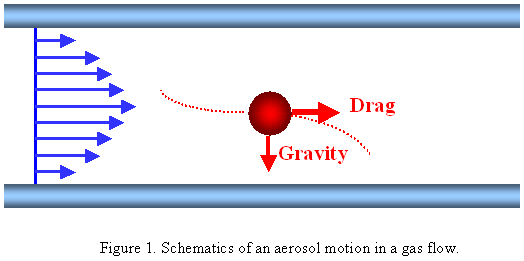|
Aerosol Kinetics
Equation of Motion
Consider an aerosol particle in a fluid flow as shown in figure 1. The
equation of motion of a sphericle aerosol particle of mass m
and diameter d is given as

|
(1)
|
Here up is the particle veolocity, uƒ is the
fluid veolocity, g is the acceleration
of gravity and the buoyancy effect in air is neglected. Here it is
assumed that the particle is away from walls and Stokes drag is assumed.

Dividing Equation 1 by  and rearranging, we find and rearranging, we find

|
(2)
|
where the particle response(relaxation)time is defined as

|
(3)
|
where  , ν is the kinematic
viscosity of the fluid and S = ρp/ρf is the
density ratio. In practice, for non-Brownian particles, Cc≈1 and , ν is the kinematic
viscosity of the fluid and S = ρp/ρf is the
density ratio. In practice, for non-Brownian particles, Cc≈1 and

|
(4)
| | 


























 and rearranging, we find
and rearranging, we find


 , ν is the kinematic
viscosity of the fluid and S = ρp/ρf is the
density ratio. In practice, for non-Brownian particles, Cc≈1 and
, ν is the kinematic
viscosity of the fluid and S = ρp/ρf is the
density ratio. In practice, for non-Brownian particles, Cc≈1 and
